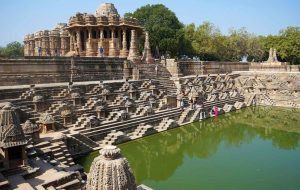
Saurashtra, also known as Kathiawar, is a peninsular region in Gujarat, India, located on the Arabian Sea coast. It covers approximately one-third of Gujarat state, including Rajkot District and 11 other districts. It used to be a state in India before merging with Bombay state in the past. It then separated from Bombay and joined Gujarat in 1961. The Kathi Darbar once ruled the majority of the region, leading to the peninsula being referred to as Kathiawar. Nevertheless, Saurashtra is not precisely synonymous with Kathiawar since a small historical Saurashtra portion extends further than the Kathiawar peninsula. Sorath comprises the peninsula’s southern section.
A few experts claim that the name Saurashtra is derived from Saura Rashtra, where Saura connotes Sun and Rashtra connotes country in Sanskrit. It means “country of the Sun,” and twelve sun temples existed in the ancient times of this area. Saurashtra is renowned for its diverse dynamics, with the region oscillating between the hustle-bustle of the cities and the peaceful life of the villages. It is known for its famous holy temples atop hills, majestic architectural sites, stunning beaches, and a notable wildlife sanctuary. Saurashtra is also home to some of the most significant spiritual places in Gujarat, including the first Jyotirlinga among the twelve Jyotirlingas of Lord Shiva, located in Somnath, where the Moon worshipped Lord Shiva. Saurashtra is truly a spiritual, religious, cultural, and historical place that must be explored.
Sacred mountain girnar is also known as Revatak Parvata, rising dramatically from the plains, is covered with glorious and ancient Jain and Hindu temples.
Pilgrims from far and wide come to tackle the long climb up 10,000 stone steps to the summit, which is best begun at dawn . Ascending in the early morning light is a magical experience, as pilgrims and porters trudge up the steps.
The Jain temples, a cluster of mosaic-decorated domes interspersed with elaborate stupas, are about two-thirds of the way up. The largest and oldest is the 12th-century Temple of Neminath, dedicated to the 22nd Tirthankar: go through the first left-hand doorway after the first gate . The nearby triple Temple of Mallinath, dedicated to the ninth Tirthankar, was erected in 1177 by two brothers. During festivals, this temple is visited by several monks and spiritual heads.
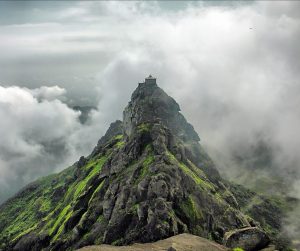
Further up are various Hindu temples. The first peak is topped by the Temple of Amba Mata Shakti peeth ,which is abode of devi amba (spouse of lord shiva , worshipped by locals in gujrat as ma amba ) where newly-weds worship to ensure a happy marriage. Beyond here there is quite a lot of down as well as up to reach the other four peaks and further temples.
The Temple of Gorakhnath is perched on Gujarat’s highest peak at 1117m. Gorakhnath shrine is small yet very unique and significant in many ways , guru gorakshnath paduka is kept here from time of “satyuga” when gorakhnath did sadhna (penance) here on girnar mountain.The steep peak Dattatraya is topped by a shrine to a three-faced incarnation of Vishnu. The ultimate guru who remain hidden compared to other lord Vishnu avatars such as lord Rama & krishna , yet duttatreya holds tremendous significance in Hinduism as hidden mystic who is responsible for spreading yoga path along with gyana path in ancient India, duttatreya is also ultimate guru for aghori’s all over the world, hence girnar holds very important place in aghora path as well. Atop the final outcrop, Kalika is a shrine to the goddess Kali where only intense devotees and locals are allowed to visit hence it is difficult to get there for a normal person and energies of that devi shrine is very intense.
Girnar mountain is also home to many rare species of plants and animals , including endangered Asiatic lions. Which does no harm to any devotees or visitors ever here in girnar mountain and in girnar velly. Girnar mountain is also famous for its awestruck view of sunrises and sunsets.
According to popular tradition documented by J. Gordon Melton, the first Siva temple at Somanath is believed to have been built at some unknown time in the past. The second temple is said to have been built at the same site by the “Yadava kings” of Vallabhi around 649 CE. In 725 CE, Al-Junayd, the Arab governor of Sindh is said to have destroyed the second temple as part of his invasions of Gujarat and Rajasthan. The Gurjara-Pratihara king Nagabhata II is said to have constructed the third temple in 815 CE, a large structure of red sandstone.
In 1024, during the reign of Bhima I, the prominent Turkic ruler Mahmud of Ghazni raided Gujarat, plundering the Somnath temple and breaking its jyotirlinga. He took away a booty of 20 million dinars. Historians expect the damage to the temple by Mahmud to have been minimal because there are records of pilgrimages to the temple in 1038, which make no mention of any damage to the temple. However, powerful legends with intricate detail developed in the Turko-Persian literature regarding Mahmud’s raid, which “electrified” the Muslim world according to scholar Meenakshi Jain. They later boasted that Mahmud had killed 50,000 devotees who tried to defend the temple.
The temple at the time of Mahmud’s attack appears to have been a wooden structure, which is said to have decayed in time (kalajirnam). Kumarapala (r. 1143–72) rebuilt it in “excellent stone and studded it with jewels,” according to an inscription in 1169. During its 1299 invasion of Gujarat, Alauddin Khalji’s army, led by Ulugh Khan, defeated the Vaghela king Karna, and sacked the Somnath temple. Legends in the later texts Kanhadade Prabandha (15th century) and Khyat (17th century) state that the Jalore ruler Kanhadadeva later recovered the Somnath idol and freed the Hindu prisoners, after an attack on the Delhi army near Jalore. However, other sources state that the idol was taken to Delhi, where it was thrown to be trampled under the feet of Muslims. These sources include the contemporary and near-contemporary texts including Amir Khusrau’s Khazainul-Futuh, Ziauddin Barani’s Tarikh-i-Firuz Shahi and Jinaprabha Suri’s Vividha-tirtha-kalpa. It is possible that the story of Kanhadadeva’s rescue of the Somnath idol is a fabrication by the later writers. Alternatively, it is possible that the Khalji army was taking multiple idols to Delhi, and Kanhadadeva’s army retrieved one of them.
The temple was rebuilt by Mahipala I, the Chudasama king of Saurashtra in 1308 and the lingam was installed by his son Khengara sometime between 1331 and 1351.[29] As late as the 14th century, Gujarati Muslim pilgrims were noted by Amir Khusrow to stop at that temple to pay their respects before departing for the Hajj pilgrimage. In 1395, the temple was destroyed for the third time by Zafar Khan, the last governor of Gujarat under the Delhi Sultanate and later founder of Gujarat Sultanate.[31] In 1451, it was desecrated by Mahmud Begada, the Sultan of Gujarat. In 1546, the Portuguese, based in Goa, attacked ports and towns in Gujarat including Somnath and destroyed several temples and mosques. By 1665, the temple, one of many, was ordered to be destroyed by Mughal emperor Aurangzeb. In 1702, he ordered that if Hindus revived worship there, it should be demolished completely.
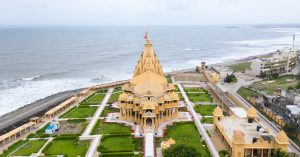
During olden times if extended to the present Sun temple Sheetla. It’s still evident from the temple of Sun God Nagradil the population of which was known as ‘Nagrapur’. Here the rivers Triveni Ganga and Hiranya Sarita had stone lined banks or ghats. Archeological explorational excavation carried out several years ago had discovered pre-vedic era specimens. Archeological examinations have concluded, beginning, rise and fall of more than 500 civilizations. According to historians, during prehistoric times the place was populated by ‘Meenurs’. From here goods were traded between several Asian ports, both exporting and importing there. Reconstruction during 1950–1951 K.M. Munshi with archaeologists and engineers of the Government of India, Bombay and Saurashtra, with the ruins of Somnath Temple in the background, July 1950.
Before independence, Prabhas Patan was part of the princely state of Junagadh, whose ruler had acceded to Pakistan in 1947. After India refused to accept his decision, the state was made a part of India and Deputy Prime Minister Patel came to Junagadh on 12 November 1947 to direct the stabilization of the state by the Indian Army and at the same time ordered the reconstruction of the Somnath temple.
When Patel, K. M. Munshi and other leaders of the Congress went to Mahatma Gandhi with their proposal to reconstruct the Somnath temple, Gandhi blessed the move, but suggested that the funds for the construction should be collected from the public and the temple should not be funded by the state. He expressed that he was proud to associate himself to the project of renovation of the temple. However, soon both Gandhi and Sardar Patel died and the task of reconstruction of the temple continued under Munshi, who was the Minister for Food and Civil Supplies, Government of India headed by Prime Minister Jawaharlal Nehru.
The ruins were pulled down in October 1950 and the mosque present at that site was shifted few kilometres away. In May 1951, Rajendra Prasad, the first President of the Republic of India, invited by K M Munshi, performed the installation ceremony for the temple.The President said in his address, “It is my view that the reconstruction of the Somnath Temple will be complete on that day when not only a magnificent edifice will arise on this foundation, but the mansion of India’s prosperity will be really that prosperity of which the ancient temple of Somnath was a symbol.”. He added “The Somnath temple signifies that the power of reconstruction is always greater than the power of destruction.”
One of the 12 Jyotirlingas Shrines of Shiva, Somnath Temple is also the specimen of fine architecture. Dubbed as Eternal Shrine, it is believed to be the place where Lord Krishna ended his Lila and thereafter for heavenly abode. This legendary temple is said to have vandalized numerous times in the history but with the help of zealot Hindu Kings the temple was rebuilt each time. Here in this blog we bring to you facts and legends that are attached to this sacred and architecturally marvelous temple.
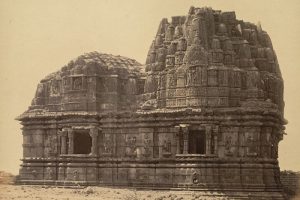
The modern day Somnath Temple was built over five years, from 1947 to 1951 and was inaugurated by then President of India Dr Rajendra Prasad. The Shivalinga in the temple is believed to have been safely hiding within its hollowness the famous Syamantak Mani, the Philosopher’s stone, which is associated with Lord Krishna. It is said that it was a magical stone, which was capable of producing gold. It is also believed that stone had alchemic and radioactive properties and could create a magnetic field around itself that helped it remain floating above ground.
The temple finds its reference in the most ancient texts of Hindus like Shreemad Bhagavat, Skandpuran, Shivpuran and Rig-Veda which signifies the importance of this temple as one of the most popular pilgrimage sites in India. According to history scholars, the site of Somnath has been a pilgrimage site from ancient times as it was said to be the confluence point known of three rivers, Kapila, Hiran and the mythical Saraswati. The confluence was called as Triveni Sangam and is believed to be the place where Soma, the Moon god bathed and regained his lustre. The result is reckoned to be the waxing and waning of the moon or the waxing and waning of the tides at this sea shore location.
The legend has it that the initial structure of the temple was first built by Moon God who constructed the temple with gold. The Sun God used silver for its construction, whereas Lord Krishna made it with the help of sandalwood. According to Hindu scholar, Swami Gajanand Saraswati, the first temple was built 7, 99, 25,105 years ago as derived from the traditions of Prabhas Khand of Skand Puran. The temple was suffer destruction at the hands of Mahmud Ghazni in 1024, Khilji’s army in 1296 , Muzaffar Shah in 1375, Mahmud Begada in 1451 and Aurangzeb in 1665.
The temple is said to be situated at such a place that there is no land in straight-line between Somnath seashore till Antarctica. In an inscription in Sanskrit, found on the Arrow-Pillar called Baan-Stambh erected on the sea-protection wall at the Somnath Temple is stated that the temple stands at a point on the Indian piece of land, which happens to be the first point on land in the north to the south-pole on that particular longitude.
According to Skanda Purana, the name of Somnath Temple will change every time the world is reconstructed. It is believed when Lord Brahma will create a new world after ending the recent one, Somnath will acquire the name of Pran Nath Temple. On the walls of the temple, along with Shiva, the sculptures of Lord Brahma and Vishnu can also be seen. According to the Prabhaskhand of Skanda Purana, answering to the question of Parvati, Lord Shiva reveals that so far Somnath has been named 8 times. According another reference in the Skanda Purana, there have been about 6 Brahmas. This is the era of 7th Brahma who is called Shatanand. Lord Shiva also reveals that in the 7th Yuga, the name of the temple is Somnath and in the last Yuga the Shivlinga was called Mrityunjay.
Dwarka is a town and municipality of Devbhumi Dwarka district in the state of Gujarat. It is located on the western shore of the Okhamandal Peninsula on the right bank of the Gomti river at the mouth of the Gulf of Kutch facing the Arabian Sea.
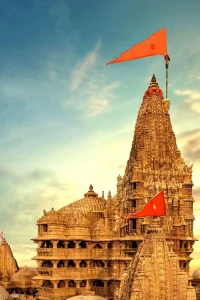
Dwarka has the Dwarkadhish Temple dedicated to Lord Krishna, which is one of four sacred Hindu pilgrimage sites called the Chardham, which were founded by Adi Shankaracharya (686–717 CE) at the four corners of the country, was established as a monastic center and it forms part of the Dwarka temple complex.Dwarka is also one of the seven-most-ancient religious cities (Sapta Puri) in India.
Dwarka is part of the “Krishna pilgrimage circuit” which includes Vrindavan, Mathura, Barsana, Gokul, Govardhan, Kurukshetra and Puri.It’s one of 12 heritage cities across the country selected under the Heritage City Development and Augmentation Yojana (HRIDAY) scheme of the Government of India to develop civic infrastructure.
Dwarka is considered as the first capital of Gujarat.The city’s name literally means gateway.Dwarka has also been referred to throughout its history as “Mokshapuri”, “Dwarkamati”, and “Dwarkavati”. It is mentioned in the ancient epic period of the Mahabharata.According to legend, Krishna settled here after he defeated and killed his uncle Kamsa at Mathura.This mythological account of Krishna’s migration to Dwarka from Mathura is closely associated with the culture of Gujarat.Krishna is also said to have reclaimed 12 yojanas or 96 square kilometres (37 sq mi) of land from the sea to create Dwarka.
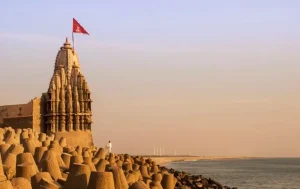
Dwarka was established as the capital in Saurashtra by the Vedic Indians during the Puranaic.[citation needed] The Yadavas, who had migrated from Mathura, established their kingdom here when the city was known as “Kaushathali”. It was during this period that the city underwent rebuilding and was named Dwarka. A friendly population of natives also prompted Krishna to settle at Dwarka when he decided, after fighting Jarasandha, the king of Magadha, to retreat from Mathura. The kingdom, also known as the Yaduvanshi empire, was established by Uugrasena, father of Kansa the then ruler and later Krishna flourished and extended its domain. It is said that Krishna conducted the administration of his kingdom from Dwarka while residing with his family in Bet Dwarka. The city’s Dwarkadhish Temple dedicated to Krishna was originally built around 2,500 years ago, but was destroyed by Mahmud Begada rulers and subsequently rebuilt in the 16th century. The temple is also the location of Dwaraka maţha, also called Sharada Matha/Peeth and “western peeth”. one of the four peeths (Sanskrit: “religious center”) established by Adi Shankaracharya. As an important pilgrimage centre for Hindus, Dwarka has several notable temples, including Rukmini Devi Temple, Gomti Ghat, and Bet Dwarka. There is also a lighthouse at the land end point of Dwarka.
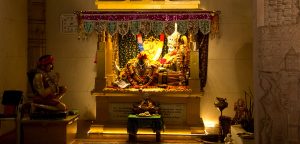 Krishna’s birthplace is known as Shri Krishna Janmabhoomi, but not many are aware of the Bhalka Teerth region, where Krishna apparently left his mortal body. This place is considered one of the most sacred sites in the “saurashtra” region of Gujarat.
Krishna’s birthplace is known as Shri Krishna Janmabhoomi, but not many are aware of the Bhalka Teerth region, where Krishna apparently left his mortal body. This place is considered one of the most sacred sites in the “saurashtra” region of Gujarat.
Bhalka Tirtha , located in “saurashtra ” region on the western coast of Gujarat, India, is the place where lord Krishna left his body. It is said that he was killed by an arrow shot by a hunter named Jara, with Krishna’s body suffering severe and subsequently fatal injuries. according to Puranas such as (Shri Krishna Nijdham Prasthan Leela) , Bhalka is part of the Lord Krishna circuit (Mathura, Vrindavan, Barsana, Govardhan, Kurukshetra and Dwarka).
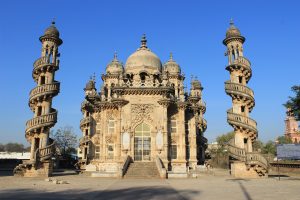 Junagadh, also known as soul of Saurashtra, welcomes travellers with its glorious architecture, bustling ,busy bazaars, a population which is famous for its warm welcome and a 2,300-year-old history. The fortified city is situated at the foot of mystical Mt Girnar, the highest point in the state of Gujarat, and lies at an elevation of 1,000 m. Dotted with grand palaces, forts and cave temples, Junagadh offers visitors a chance to taste the diverse palate of its rich history that can be seen in its beautiful monuments. A gateway to the Somnath Temple and the Gir National Park, Junagadh mesmerises one with its heritage charm.
Junagadh, also known as soul of Saurashtra, welcomes travellers with its glorious architecture, bustling ,busy bazaars, a population which is famous for its warm welcome and a 2,300-year-old history. The fortified city is situated at the foot of mystical Mt Girnar, the highest point in the state of Gujarat, and lies at an elevation of 1,000 m. Dotted with grand palaces, forts and cave temples, Junagadh offers visitors a chance to taste the diverse palate of its rich history that can be seen in its beautiful monuments. A gateway to the Somnath Temple and the Gir National Park, Junagadh mesmerises one with its heritage charm.
Gir National Park and Wildlife Sanctuary, also known as Sasan Gir, is a forest, national park, and wildlife sanctuary near Talala Gir in Gujarat, India. It is located 43 km (27 mi) north-east of Somnath, 65 km (40 mi) south-east of Junagadh and 60 km (37 mi) south-west of Amreli. It was established in 1965 in the erstwhile Nawab of Junagarh’s private hunting area, with a total area of 1,410.30 km2 (544.52 sq mi), of which 258.71 km2 (99.89 sq mi) is fully protected as a national park and 1,151.59 km2 (444.63 sq mi) as wildlife sanctuary. It is part of the Khathiar-Gir dry deciduous forests ecoregion.
Gir National Park is the only place in the world outside Africa where a lion can be seen in its natural habitat. The lions of Gir are a majestic animal, averaging 2.75 metres in length, and with a bigger tail tassle, bushier elbow tufs and prominent belly folds than his African cousin which has larger mane. Gir is a home to 40 species of mammals and 425 species of birds.

We all know, Gir is the only natural habitat of world popular Asiatic Lions. Where our tailor made Gir Wild Life gives you an unparalleled opportunity to watch those rare Asiatic Lions coupled with thousands of other elusive wild animals and hard-to-find birds like uncommon Asiatic wild ass, hyenas, Gir foxes, pygmy woodpecker, brown fish owl and black buck etc.
The count of 2,375 distinct fauna species of Gir includes about 38 species of mammals, around 300 species of birds, 37 species of reptiles and more than 2,000 species of insects. The carnivores group mainly comprises the Asiatic lion, Indian leopard, jungle cat, striped hyena, golden jackal, Bengal fox, Indian gray mongoose, ruddy mongoose, and honey badger. Asiatic wildcat and rusty-spotted cat occur, but are rarely seen.
The main herbivores of Gir are chital, nilgai, sambar, four-horned antelope, chinkara and wild boar. Blackbucks from the surrounding area are sometimes seen in the sanctuary. Among the smaller mammals, porcupine and hare are common, but the pangolin is rare.
The reptiles are represented by the mugger crocodile,[8] Indian cobra, tortoise and monitor lizard which inhabit the sanctuary’s bodies of water. Snakes are found in the bush and forest. Pythons are sighted at times along the stream banks. Gir has been used by the Gujarat State Forest Department which formed the Indian Crocodile Conservation Project in 1977 and released close to 1000 marsh crocodiles into Lake Kamaleshwar and other small bodies of water in and around Gir.
The plentiful avifauna population has more than 300 species of birds, most of which are resident. The scavenger group of birds has 6 recorded species of vultures. Some of the typical species of Gir include crested serpent eagle, endangered Bonelli’s eagle, changeable hawk-eagle, brown fish owl, Indian eagle-owl, rock bush-quail, Indian peafowl, brown-capped pygmy woodpecker, black-headed oriole, crested treeswift and Indian pitta. The Indian grey hornbill was not found from the last census of 2001.
Sonal Patel
+1 734 725 1294